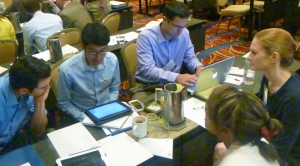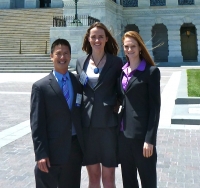By Julia Bradley-Cook, PhD Candidate in Ecology and Evolutionary Biology at Dartmouth College
Science and policy are inextricably linked: science informs decisions we make at local to international levels, and policy determines the budgets and priorities that drive research. As an ecology PhD student interested in societal issues, I am compelled to complement my scientific graduate training with an understanding of science policy. The American Meteorological Society (AMS) Summer Policy Colloquium offers one such opportunity—an introduction to science policy in Washington D.C. The colloquium is an immersive ten-day experience that gives participants an understanding of the policy process and arms them with tools to engage with decision makers.
In the beginning of June, I was awarded National Science Foundation funding to attend the AMS colloquium, along with two other PhD fellows in Dartmouth's polar environmental change Integrative Graduate Education and Research Traineeship (IGERT), an NSF-funded program. Alexandra Giese, Gifford Wong, and I joined a group of 36 participants, including graduate students from 13 universities, post-docs, professors, a science educator, research scientists, and professionals from the federal government and industry. With expertise that ranged from weather forecasting to social science to climate modeling, our diverse backgrounds made for insightful discussions with speakers, dynamic participation in activities, and engaging conversations over meals and coffee breaks.
The colloquium started with a crash course on the fundamentals of science policy. We learned about the key structures and roles in the legislative branch, along with the procedures and politics that guide the policy-making process. This foundation prepared us for the subsequent sessions, in which we met experts in government affairs, military and defense, international affairs, science communication, science policy careers, and leadership.
To learn about the legislative branch, we visited Congress and met staffers from both sides of the aisle in the Senate and House of Representatives. We had candid discussions about the congressional politics and gained a sense of "how the sausage is made." We also learned about the executive branch from presentations by experts from the Office of Science and Technology Policy and the Office of Management and Budget, who spoke about the use of science in the Administration and the complex budget process.
After three days of domestic science policy, we broadened our perspective to the international level. We gained a historical perspective of U.S. climate policy, including international negotiations, regional cap and trade initiatives, and executive orders enacted during the Obama Administration. We heard about climate, weather, and environmental programs that forge relationships with other countries. I was especially interested to learn about science diplomacy, which entails the use of international science as a tool to enable communication and partnerships around shared goals. A number of speakers highlighted the Arctic, including noting the significance of United State's upcoming role as Chair of the Arctic Council.
In addition to the meetings and lectures, we participated in two hands-on exercises to deepen our understanding of the policy process. First, we played the role of Senators in the Energy and Natural Resources Committee and met to consider climate change risk management legislation. We learned amendment strategies and acted out a simplified version of the committee process to mark-up and vote on the bill that would be sent to the Senate floor. Second, we took on a water resource management case study to conceptualize inter-agency coordination among the U.S. Army Corps of Engineers, the National Weather Service, and the U.S. Geological Survey to address water resource management challenges, such as drought in the western U.S. We discussed the needs, opportunities, and challenges of such collaboration, and received feedback from expert panelists.

Towards the end of the colloquium we spent a full day on science communication to explore tools and best practices for communicating with decision makers and public. Science communication specialists from the American Geophysical Union hosted the workshop, including interactive storytelling and message-crafting activities. The workshop aligned well with an overriding message from the colloquium: relationships are important. Scientists need to cultivate relationships with decision makers in order to understand, connect with, and effectively communicate with them. This effort requires listening and communication skills that go beyond manuscript writing and professional presentations.
At the end of the colloquium, Dr. William Hooke, the founder and generous mentor of the colloquium, posed a big question to the group: "In 100 years, do you think the Earth will be a better or worse place?" We discussed the very serious challenges that we face: climate change, unpredictable threats to life, and widespread human impact on the earth system. As Dr. Hooke pointed out, we are solving tomorrow's problems with yesterday's technologies. On the other hand, many people expressed optimism about the opportunity for science and innovation to address challenges. There are many smart, passionate, and motivated people who are working to tackle the grand challenges of our times.
Having met several of these people working at the federal level, I came away with a better sense of the critical role of science in the policy arena and the vast amount I have to learn about it all. I am more motivated than ever to use my skills as a scientist to bring science and a scientific perspective to policy in the next step of my career.

She is pictured here in front of the U.S. Capitol with fellow Dartmouth IGERT program participants, Gifford Wong (left) and Alexandra Giese (right). Photo courtesy of Julia Bradley-Cook.
